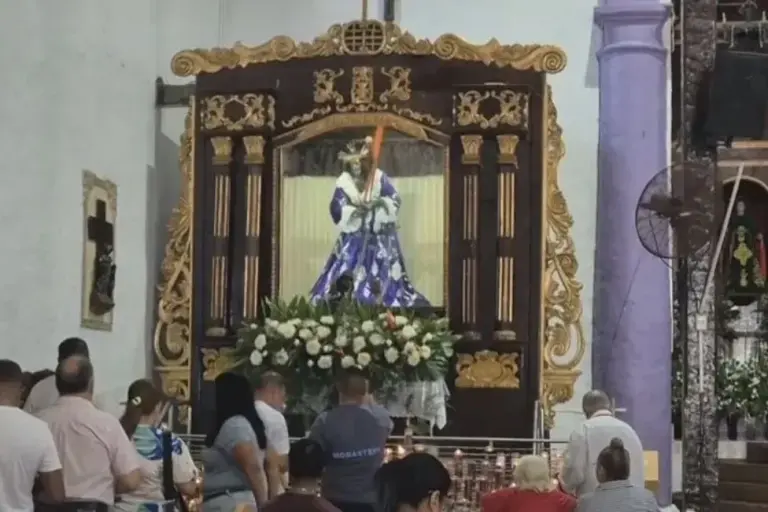PORTOBELO, Panama – Hundreds of faithful pilgrims from across Panama are walking the historic route to the San Felipe Church in Portobelo this week to honor the revered Black Christ statue in one of the country’s most profound religious traditions. The annual pilgrimage, culminating on October 21, sees devotees traveling kilometers on foot to fulfill promises, request favors, or give thanks for miracles attributed to the Nazarene.
The journey from Sabanitas to Portobelo in Colón Province has transformed into a continuous stream of worshippers, many participating in family groups while others walk alongside friends or organized religious associations. National Police have deployed over 500 officers to ensure safety along the route, with emergency services establishing hydration stations and medical assistance points for the travelers.
“I have been walking for about seven or eight years; every year is my test of faith. Since I was little, I have done it with my father, it is already a family tradition,” commented one pilgrim advancing toward the Christ of Portobelo [Translated from Spanish].
Another devotee added: “Here we are giving another year more. There is a significant police presence and hydration for those who travel the path on foot [Translated from Spanish].” The combination of deep religious conviction and community support characterizes the event, which draws participants from all socioeconomic backgrounds.
Security and Emergency Coordination for Pilgrim Safety
Colón Police Zone Chief Hermógenes Argüelles confirmed that comprehensive security measures are in place throughout the pilgrimage route, coordinated between multiple security and emergency response agencies. The security operation includes fixed checkpoints, mobile patrols, and coordinated response plans with medical teams.
“We have the connection with emergency teams, such as SUME, to ensure that people reach their destination safely,” indicated Argüelles [Translated from Spanish].
The Unified Emergency Medical Service (SUME) has established multiple assistance stations along the route, particularly focusing on areas where pilgrims face challenging terrain or extreme physical exertion. Medical personnel are treating cases of dehydration, exhaustion, and minor injuries, with ambulance services standing by for emergency transfers to medical facilities.
October 21 Climax Expected to Draw Over 100,000 Faithful
The Black Christ of Portobelo festivities will reach their peak on October 21, the main celebration date, when district authorities anticipate the arrival of more than 100,000 pilgrims to the colonial town. The massive gathering represents one of Panama’s largest religious events and requires extensive logistical planning from local and national authorities.
Portobelo’s infrastructure, including roads, public services, and temporary facilities, has been reinforced to accommodate the unprecedented influx of visitors. Local businesses and vendors have prepared for increased commercial activity, while church officials have coordinated additional masses and religious services to accommodate worshippers.
The tradition honors the mysterious statue of the Black Christ, which according to local legend arrived in Portobelo under miraculous circumstances centuries ago. The dark wooden sculpture has been venerated for generations, with many attributing healing and protection to its intercession.
Extraordinary Pilgrimage Journeys Demonstrate Depth of Devotion
Among the thousands making the journey are individuals undertaking extraordinary physical challenges to demonstrate their faith. Related coverage highlights Mario Peña, who is walking 403 kilometers from Chiriquí Province to Portobelo to honor the Black Christ. Such extreme pilgrimages represent the deepest expressions of devotion within the tradition.
These remarkable journeys often begin weeks in advance of the October 21 celebration, with pilgrims traversing multiple provinces and diverse terrain to reach their destination. Community support along these extended routes frequently provides food, water, and temporary shelter to the travelers.
“We see people walking for days, sometimes weeks, to reach Portobelo,” noted a local volunteer coordinating assistance stations. “Their determination inspires our community to provide whatever support we can offer [Translated from Spanish].”
The convergence of these long-distance pilgrims with those making shorter journeys creates a tapestry of devotion that transforms the roads leading to Portobelo into continuous processions of faith throughout October.
Weather Advisory Adds Complexity to Pilgrimage Planning
The Institute of Meteorology and Hydrology of Panama (IMHPA) has issued a weather vigilance notice for rains and storms remaining in effect until Tuesday, October 21, 2025 – coinciding directly with the pilgrimage climax. The advisory affects multiple provinces and regions along pilgrimage routes, including Colón, Panama, and Comarca Ngäbe-Buglé.
According to the national meteorology institute, the adverse weather conditions require additional precautions for pilgrims traveling on foot. Authorities have recommended that participants maintain awareness of weather updates, prepare alternative routes in case of flooding or landslides, and avoid outdoor activities during severe weather episodes.
Emergency services have adjusted their deployment strategies to account for potential weather-related incidents, with additional resources allocated to areas prone to flooding or isolated by rainfall. The coordination between meteorological authorities and security agencies represents an evolving approach to managing large-scale religious events amid changing weather patterns.
Cultural Significance and Economic Impact of Devotion
The Black Christ devotion represents not only a religious phenomenon but also a significant cultural and economic event for the Colón region. Local businesses, particularly in the hospitality, food service, and transportation sectors, experience substantial revenue increases during the pilgrimage period.
Historical preservation efforts in Portobelo, a UNESCO World Heritage Site, benefit from increased visibility during the event, though authorities balance tourism management with conservation requirements. The convergence of religious tradition and cultural heritage creates unique opportunities for community development in the colonial town.
Church officials emphasize that the event’s primary significance remains spiritual, with the economic benefits representing secondary outcomes of the deep-rooted tradition. The synchronization of religious, cultural, and economic interests requires careful coordination between ecclesiastical, governmental, and community stakeholders.
As pilgrims continue their journey toward the October 21 culmination, the streets of Portobelo prepare for the arrival of the faithful in what remains one of Panama’s most visually striking and emotionally powerful expressions of popular religiosity.



